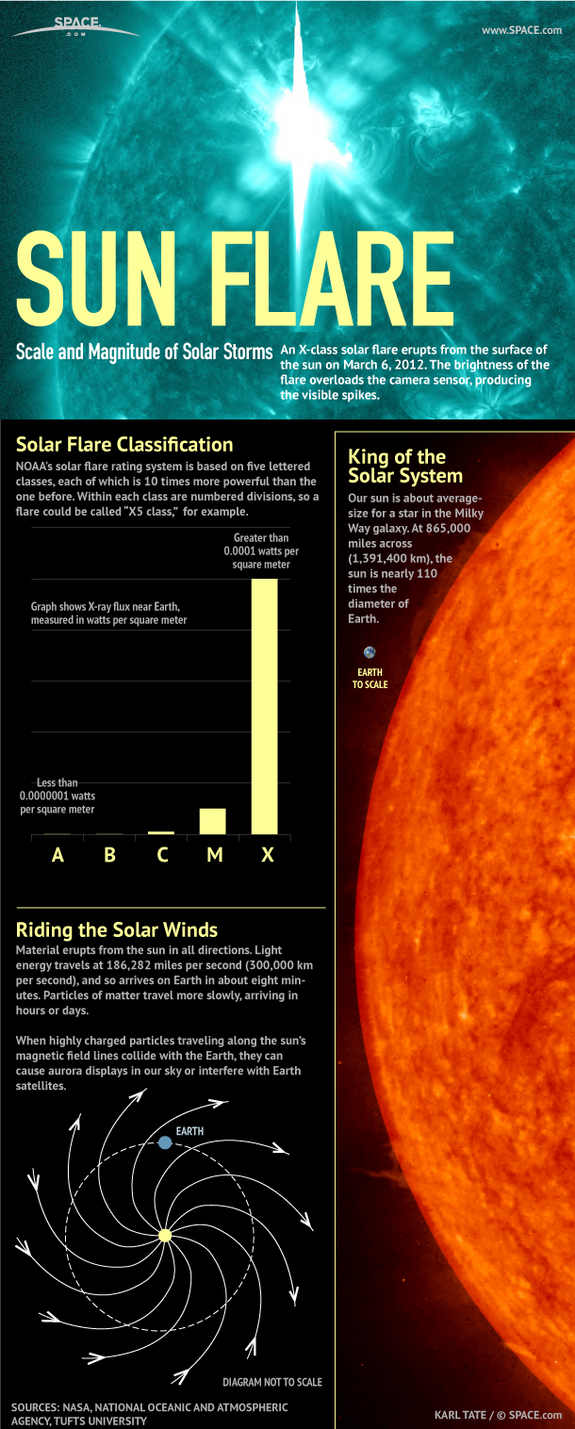Here’s a close look at the large X5.4 solar flare that erupted on the Sun on March 7, 2012 at 00:28 UT, (7:28 PM EST on March 6). These high-definition views from the Solar Dynamics Observatory also show the subsequent solar tsunami that rippled across the Sun, appearing as though the Sun ‘shook’ from the force of the flare.
This storm is heading our way and will likely give Earth’s atmosphere and magnetosphere a little shake as well, but solar physicists aren’t sure yet what the full impact will be. NASA Goddard’s Space Weather Lab and NOAA Space Weather Prediction Center say surely there will be aurorae from this blast. Other potential impacts include some radio blackouts, single-event upsets to satellite operations, and airplane passengers in high latitude, high altitude flights may experience increased radiation exposures.
This latest blast is the second largest flare during the current solar cycle. If you recall, there was an X6.9 on August 9, 2011.
After the first big blast early today, about an hour later, at 01:14 UT (8:14 PM EST, March 6) the same region let loose an X1.3 class flare. An X1 is 5 times smaller than an X5 flare, Goddard Space Flight Center said.
These X-class flares erupted from an active region named AR 1429 that rotated into view (as seen from Earth) on March 2. Before this, the same active region had already produced numerous M-class and one X-class flare, which we reported earlier. The region continues to rotate across the front of the sun, so these latest flares were more Earth-facing than the previous ones. The big blast did trigger a temporary radio blackout on the sunlit side of Earth that interfered with radio navigation and short wave radio.
More on that solar tsunami, which are also called blast waves or coronal EIT waves. Scientists from the Goddard Spaceflight Center say the waves move at over a million miles per hour, zipping from one side of the Sun to the other in about an hour. The movie shows two distinct waves. The first seems to spread in all directions; the second is narrower, moving toward the southeast. Such waves are associated with, and perhaps trigger, fast coronal mass ejections, so it is likely that each one is connected to one of the two CMEs that were associated with the flares.
The waves are called EIT waves because they were first discovered with the Extreme ultraviolet Imaging Telescope (EIT) on the Solar Heliospheric Observatory.
Solar physicist Dr. C. Alex Young does a great job of explaining what took place on the Sun in this video:
And Space.com has a nice graphic (which they kindly shared!) that explains solar flares.

Source: SPACE.com: All about our solar system, outer space and exploration
Sources and more info: NASA, Goddard Space Flight Center

ham radio operators love these conditions. the ionosphere becomes reflective to EM signals at varying altitudes to produce novel propagation modes. the amount (and angle) of reflection varies with signal frequency and they bounce ‘skip’ around the earth.
o so fun.
Active Region AR 1429 should read AR 11429.
X5.4… pretty decent. Guess we’ll start to see them increase in frequency as we come closer to solar maximum… Let’s hope we stay lucky and this is the biggest shot that’s pointed at us. Wouldn’t be fun having that X45 from 2003 hit us head on…
whereever/whomever provided the music needs to be credited as well!!
What defines a “solar cycle”?
Why do the videos on UT restart when full screen selected? Seems this started happening recently.